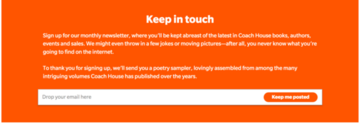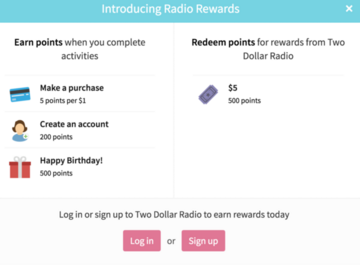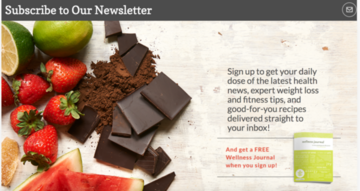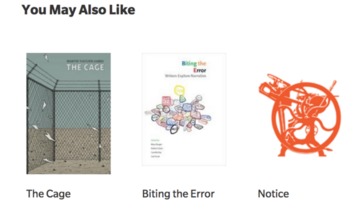If you’re interested in building more community around your publishing program, encouraging more engagement with your authors and books, and driving sales, you need a solid email marketing strategy.
While email may seem old in the context of a communications landscape saturated with new social media platforms, leading digital researchers consider email marketing to be more powerful than ever. McKinsey & Company reports the following:
Email is 40x more effective at acquiring new customers than Facebook or Twitter.
This is, in part, because of the huge number of people who use email daily (91%). McKinsey & Company also found that the rate at which email prompts purchases is estimated to be at least 3x that of social media.
Let us assume, however, that these awesome stats (of which there are many more in the same vein) relate to goodemail marketing … not all email marketing.
When considering an email marketing strategy, there are three goals to achieve:
- Convince people to opt in to receiving emails from you;
- Create content and a schedule that makes subscribers more likely to engage with and potentially purchase your books;
- Discourage subscribers from cancelling their subscription.
1. How to encourage people to opt in to your email marketing program
There should be a call to action placed on your homepage and/or other landing pages for users to opt in to receiving emails. This needs to be easy to find and placed relatively high on the page (not just in the footer, as so many are). Crucially:
- It should be easy for the user to quickly understand the benefits of deciding to opt in;
- The call to action should not simply be “Stay up to date by subscribing to our email newsletter.”
“Stay up to date …” is boring, and it assumes that people need to stay up to date with what you’re doing. Most people really don’t. But virtually all your potential subscribers love books, love insider perks, and love contests and discounts. And very likely, there’s a way of working these into your call to action, by including just a little more information about the benefits of subscribing. Here’s how ReaderBound publisher Coach House Books frames it (using wonderful tone, as always):
Figure 1: Coach House offers a poetry sampler (and humour) for signing up.
Compare Coach House’s invitation with the one below, taken from another indie press website. The latter is far more common and far less tempting.
Figure 2: A boring call to action presented without any other information.
Another publisher that makes it immediately and powerfully clear that subscribing will result in really good things is Two Dollar Radio; they offer monetary rewards in return for user behaviours including purchases, signing up, and even for birthdays!
Figure 3: Two Dollar Radio inspires loyalty and purchases.
Like Two Dollar Radio, Rodale Books also offers rewards: health news, fitness and weight-loss tips, and a free wellness journal – which is very much on-brand for the company – in return for signing up.
What’s more, Rodale Books devotes a full and attractive landing page – which you arrive at once you click on a subscribe link on the homepage – to describing these benefits. What’s nice about this is that the emphasis isn’t on an ugly and toneless email form, but rather on an evocation of the kind of content and benefits one could expect to receive from subscribing. The positive energy that comes off the page (pictured below) makes the effort and tedium of submitting an email far less onerous than it usually is.
Figure 4: Rodale Wellness includes chocolate in their wellness plans so, yes, we will subscribe.
Common to Coach House Books, Two Dollar Radio, and Rodale Books is one thing: the understanding that you have to give something to get something … and that what you give must actually be valuable to the visitor. With that in mind, what do you have that you could give away in order to gain valuable subscribers who put their hands up to hear from you on a regular basis?
- Without much doubt, you have content (e.g., PDFs of short stories, recipes, first chapters of books).
- You may also have backlist that can be attractively bundled into a special deal.
- You might have the ability to offer surprise flash sales on one or more titles, or free shipping on orders of more than $50.
- One of your authors might agree to provide a short webinar on an element of writing (e.g., the first page, creating suspense, creating compelling characters) – chances are that you have aspiring writers interested in your press.
The point is that you likely have content, or deals, that will make subscribing to your newsletter a very exciting proposition. Make sure to highlight the benefits of subscribing alongside your call to action.
2. Create an effective schedule geared to providing value
If you’re sending out good content, as discussed above, you almost automatically won’t be sending too many emails. That’s because each email will be full of value for your subscribers rather than shameless self-promotion, and it takes time and effort to create value (but it’s worth it!).
Research shows that the majority (7 in 10) of people who unsubscribe from company emails cite “too many emails” as a reason, another reason to err on the side of a lighter email schedule than a heavier one. Once a week might be too often to hit send, unless your email strategy is to communicate a very urgent offer four times a month (e.g., “This week only, receive 50% off any backlist book!”). If you want to say more (e.g., talk about upcoming author events, highlight an amazing review, announce a new season of books), once every two weeks, or even once a month, is probably better.
Before you send the newsletter, imagine yourself as a subscriber, and one who receives a lot of email. Would the content strike a chord with you? Is there anything free or tempting that would encourage you to visit the site? Is the voice compelling and fun? Research also shows that 32% of users unsubscribe due to “irrelevant or useless” email.
3. Discourage subscribers from cancelling their subscriptions
Once you’ve got someone’s email, you’ve begun a relationship with them. As with any relationship, don’t take it for granted, don’t be too pushy, and keep it surprising and fresh. One idea for reminding subscribers that it’s a good idea to keep hearing from you is to include a content item that’s explicitly called out as exclusive to subscribers. For example, for one week, offer subscribers 50% off ANY book on your website.
It’s Subscriber Appreciation Week!
In thanks for your loyalty, we’re offering you 50% off ANY book in our website, from [date] until [date]! Use coupon code #0y45 and have fun shopping!
It sounds like a big discount, and it is, but here’s how it’s worth it: you keep your subscriber base healthy and you get people going to your website. What’s more, we all know how hard it is to buy just one book when surrounded by temptation! This well-known impulsive behaviour is the reason that at ReaderBound, we built a “You May Also Like” function into our title page features.
Figure 5: Responding to curiosity and impulsive moods on a ReaderBound site.
The Cycle of Goodness
Once you get into a cycle of attracting subscribers, pleasing them with great content interspersed with fun surprises and perks, and thanking them relatively extravagantly every so often, email marketing gets to be less of a chore and more of a fun game with a sincere core: recognizing how important relationships with your core audience really are.




